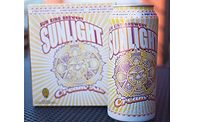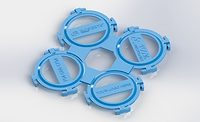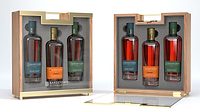Packaging Materials
Secondary packaging enhances marketing, sustainability efforts
Suppliers release new can carriers using less plastic




If you’re going to play in Texas, you gotta have a fiddle in the band. That lead guitar is hot, but not for Louisiana man,” is the 1982 Grammy award-winning country-rock anthem from Alabama. In the world of packaging materials, it’s clear that secondary packaging is no longer “playing second fiddle” as it enhances a brand’s marketing and sustainability efforts.
As beverage manufacturers strive to unlock the power and potential of secondary packaging, they have a plethora of options from which to choose, including shrink-wrap, paperboard and corrugated packaging.Bret Arnone, vice president of beverage commercial operations for Atlanta-based Graphic Packaging International (GPI), is finding that consumers and beverage producers are looking to reduce the use of plastic and to find materials made from renewable resources that are easily recyclable.
“We are seeing a focus on sustainability and premiumization,” Arnone says. “… The need to communicate a premium brand drives the use of decoration on packs, which is most significantly seen with craft breweries. More recently, we’ve seen a sharp increase in larger multipacks of 24-plus.”
Arnone points out the overall beverage industry is tasked with finding better end-of-life solutions. “Paperboard, even if not recycled, will decompose over time versus other solutions,” he says.
Although shrink-wrap film is less expensive than paperboard case, some retailers are moving away from shrink-wrap as part of their sustainability goals, says Dan Altman, vice president of sales and marketing for Delkor Systems, Arden Hills, Minn.
To improve in-store efficiencies, retailers are turning to retail-ready packaging such as the Delkor Turbo Case and the Delkor Cabrio Case, which enable convenience store clerks to more easily and quickly restock shelves, Altman says. The Cabrio Case is formed from a single-piece corrugated blank, which saves around 30 percent of corrugated material compared with traditional tray hood packages, Altman says. It also imparts a fully branded and fully stocked display tray that easily slides onto empty store shelves.
When it comes to giving customers a differentiated paper and packaging solutions, Norcross, Ga.-based WestRock offers several responsibly sourced renewable materials, including wood fiber, which is inherently well-suited to the circular economy. The company also operates one of the largest third-party certified fiber procurement systems, notes Jeremy Keenan, vice president of strategic marketing at WestRock.
Although paper fibers are not infinitely recyclable, the company combines virgin fiber and recycled content for its CarrierKote paperboard, a high wet strength grade specifically designed for the unique needs of the beverage market. The paperboard balances virgin hard and soft wood with as much as 15 percent recycled content.
Ringing perfection
In addition to developing fiber-based outer solutions, packaging innovators are designing new plastic rings with less plastic material. For instance, Roberts PolyPro, a brand of ProMach, Charlotte, N.C., has seen growing demand for its plastic multipack can and bottle carriers because they use as much as 30 percent less plastic than other carriers.
Roy Tetreault, general manager for Roberts PolyPro, notes that sleek aluminum cans and slim beverage can carriers are supporting the growth of these new beverage can formats. “Roberts PolyPro Craft-Pak sleek and slim can carriers offer two on-trend innovations: their open-ring design uses up to 30 percent less plastic than other can carriers and their patent-pending T-Clips makes it easy for consumers to remove cans without tugging, struggling or shaking the cans,” he says.
Offering a fiber-based solution, WestRock offers a range of CanCollar products as a multipack replacement for plastic rings. In late 2019, GPI launched its KeelClip solution, a paperboard alternative to plastic rings and film for carrying multipacks of canned items that can be applied at high speeds, Arnone says.
The magic of multipacks
Experts note that variety packs of hard seltzers, flavored waters and ready-to-drink teas and juices are on the rise, with a host of secondary packaging options to use.
“HDPE and LDPE plastic can and bottle carriers are ideal for multipacks. They make it easy for consumers to purchase two-, three-, four-, six- or even eight-packs of products from supermarkets, convenience stores, beverage carry-outs and club stores,” Roberts PolyPro Tetreault says. “And brand owners love selling multipacks.”
Multipacks also are prime real-estate for marketing brand attributes through logos, color, graphics and eye-catching decoration.
“This is the first thing a consumer sees when shopping and purchasing at retail. It is also part of the at-home experience, whether loaded into the refrigerator or sitting in the pantry,” GPI’s Arnone says. “Paperboard packaging provides needed protection while also delivering branding opportunities for beverage companies to tell their story and stand out in a highly competitive space.”
When considering what type of secondary packaging to utilize, WestRock’s Keenan says the company —through its Packaging Matters research — works with brand owners to translate their brand’s strategy into relevant and cohesive packaging and display solutions that provide a critical moment of truth in the aisle.
“Our Packaging Matters research show that packaging can play a larger role between brands and consumers by facilitating trust and connection,” Keenan explains. “The challenge before us is to move toward packaging that is renewable, recyclable and performs throughout our customers’ supply chains. We are partnering with our customers to do just that.”
Looking for a reprint of this article?
From high-res PDFs to custom plaques, order your copy today!









